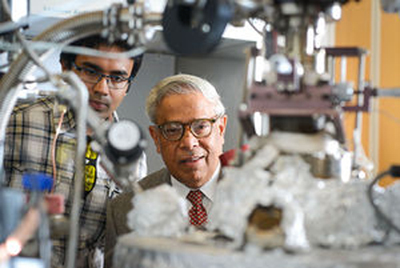
Diamonds might be forever, but they're no longer nature's hardest material. Researchers at NC State have broken that mold, though, with their discovery of Q-carbon.

Diamonds might be forever, but they're no longer nature's hardest material. Until recently, graphite and diamond were the only known solid phases of carbon. Researchers at NC State have broken that mold, though, with their discovery of Q-carbon.
"A cut above the rest:" the novel phrase often used actually has promising applications, according to Jagdish Narayan, research leader and John C. C. Fan distinguished chair professor in the Department of Materials Science and Engineering. These applications, Narayan explained, are particularly important to the realms of medicine and technology.
The diamond's newfound rival is created using a meticulous, yet rapid process. At regular room temperatures and pressures, amorphous carbon is exposed to powerful lasers, driving up the temperature of the carbon to 6,740 degrees Fahrenheit in nanoseconds, according to Narayan.
Thus, the melted carbon is quenched — hence the "Q," or cooled, forming the Q-carbon. Outside of the lab, the only place it might exist is in Earth's core, buried under miles of molten rock.
"What we're doing here is bypassing thermodynamics," Narayan said. "Converting carbon into diamond at low pressures has been a dream for scientists across the world."
The bonds between atoms shorten and don't have time to re-lengthen as the material cools, which resultantly makes the substance denser and harder than diamond. If not cooled properly, the atoms revert to graphite. According to Narayan, the difference between carbon and diamond relates to the arrangement of outer-fold electrons.
Synthetic diamonds have been manufactured since the mid-1950s. Lab-made methodologies have required expensive equipment to expose the graphite to high temperatures, pressures and hydrocarbon gases.
The innovative Q-carbon technique is inexpensive and relatively simple. Thanks to the laser technology, notably used in Lasik eye surgery, a carat can be created in 15 minutes, according to Narayan.
"When you get laser eye surgery, you're essentially putting a nuclear reactor in your eye," Narayan said. "But, what happens is it lasts for such a short time that it doesn't do any damage. That's the beauty of the surgery. The high-powered laser basically manipulates the electrons."
Narayan explained that the true brilliance of the Q-carbon lies in its unique properties. For instance, the form sets itself apart with its ferromagnetism, which has prospective biomedical applications, such as a biological implant that can sense magnetic fields. By controlling the nucleation and growth, nanodiamonds, microdiamonds and nanodots can be produced.
"A nanodiamond is the best drug-delivery vehicle," Narayan said. "We create a nanodiamond, which can be coated with a drug, which could go into the cell and kill the cancerous cell. The nanodiamond is totally biodegradable and the least toxic material we have known [for drug delivery]."
Justin Schwartz, department head of materials science and engineering, said the finding was "remarkable on many levels."
"Human-made diamonds that can be produced quickly and inexpensively have been sought after for years, but this has the potential to be so much more than that," Schwartz said. "Only time will tell just how broad the impact will be."
"What interests me is how I can help do the maximum good for humankind," Narayan said. "That's what drives me. It's not just that I'm working hard — I'm having fun."